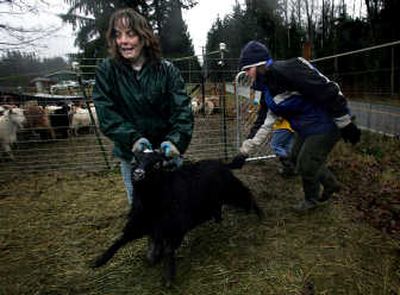Goat-lover opens arms, farm to herd of unruly foster kids

ARLINGTON, Wash. – Ellen Felsenthal grinned as a pickup with a bed full of Christmas trees pulled into her driveway. Butch and Roger Drake hopped out of the truck and lugged trees over to enclosures holding close to 100 ailing goats.
“Look. It’s goat Christmastime!” Felsenthal yelled as the men tossed the trees over the fence.
Goats immediately limped over to the trees and began feasting on the prickly pine branches.
All the goats have worms and lice. Many have hoof rot, which causes a limp. None belongs to Felsenthal. But in recent weeks, they have dominated her life.
The goats are orphans. Their former owner, an elderly woman who considered herself an animal rescuer, died in early December at her home near Lake Cavanaugh in Skagit County. She lived alone.
When sheriff’s deputies found her Dec. 8, they also found 155 goats, between 20 and 30 cats, several geese, ducks and chickens, and one llama running loose on 25 acres, according to Emily Diaz, the county’s sole animal control officer.
Though the goats had enough to eat, they were clearly sick. Some couldn’t stand.
Diaz had never dealt with so many goats before.
She called Felsenthal, a goat foster parent, for help. Felsenthal, in turn, called friends to stage a rescue. Together they rounded up the goats, built fences to contain them, and loaded them into trailers headed for Felsenthal’s Arlington farm and goat sanctuary.
“The hardest part was catching them because they were so freaked out and they didn’t want to be handled or caught,” said Felsenthal, a photography professor at Everett Community College. “We had to get each one as we could – with lassos and grabbing them by the horns, just kind of cowboying them, which is not my normal way of interacting with goats.”
By Dec. 15, 11 trailers filled with goats had been unloaded at Felsenthal’s farm.
A veterinarian euthanized about 40 that the rescue team determined could not be helped. Felsenthal buried them, some in her backyard.
The goats that remain are typical – unruly, stubborn and sometimes affectionate. They’ve eaten her holly tree and littered her yard with waste.
Felsenthal loves them.
She wakes at 7 a.m. and spends three hours each morning and night feeding them, cleaning up their mess and checking on each one. She also spends an hour or two each day on the phone and computer trying to find qualified families to adopt the goats.
Felsenthal has 10 goats of her own, five sheep, two horses, a pony, and a few cats and dogs. Because of her foster goats, she hasn’t given her other animals the attention they’re used to.
Two of her goats, Stanley and Zazu, spend much of their time on top of a compost pile Felsenthal calls “Poop Mountain,” checking out the new goats, which are quarantined in a separate enclosure.
On a recent weekend, goat lovers and three volunteer veterinarians from Pilchuck Veterinary Hospital in Snohomish worked in the rain to delouse and deworm the goats and work on their sore hooves.
About 20 were adopted, and 26 were placed with friends in “foster” goat pastures. About 80 remained.
Because two of the male goats hadn’t been neutered (surgery was scheduled), it’s possible the herd will double this spring, Felsenthal said.
Felsenthal said she felt the holiday spirt in the donations of hay, food and money she has received as word of the goat rescue spread.
“It’s been a lot of hard work,” she said, petting a black goat. “I’ve been amazed by the support I’ve received. People I know and people I don’t know have helped. There’s no way I could do this on my own.”